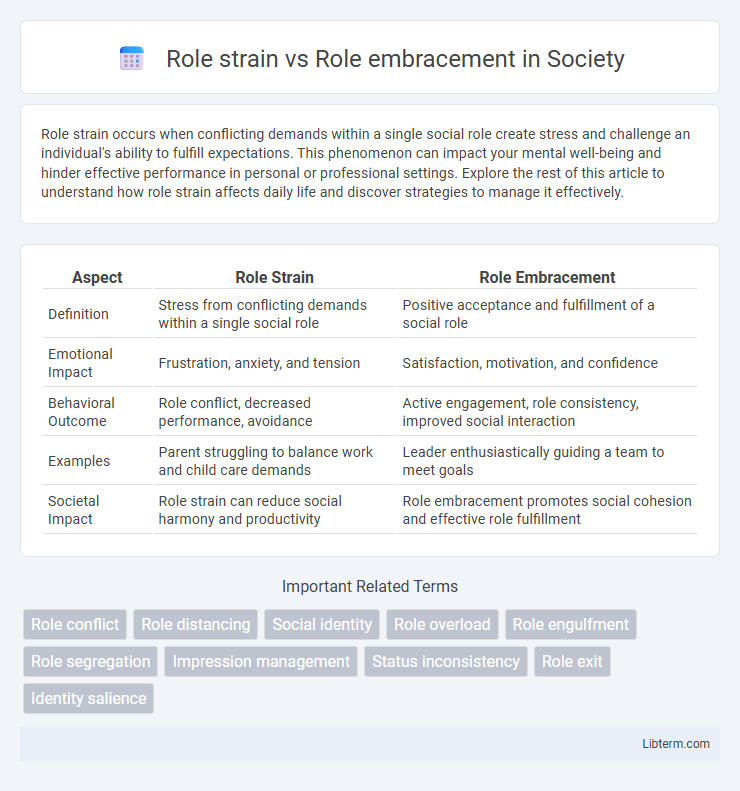Role strain occurs when conflicting demands within a single social role create stress and challenge an individual's ability to fulfill expectations. This phenomenon can impact your mental well-being and hinder effective performance in personal or professional settings. Explore the rest of this article to understand how role strain affects daily life and discover strategies to manage it effectively.
Table of Comparison
| Aspect | Role Strain | Role Embracement |
|---|---|---|
| Definition | Stress from conflicting demands within a single social role | Positive acceptance and fulfillment of a social role |
| Emotional Impact | Frustration, anxiety, and tension | Satisfaction, motivation, and confidence |
| Behavioral Outcome | Role conflict, decreased performance, avoidance | Active engagement, role consistency, improved social interaction |
| Examples | Parent struggling to balance work and child care demands | Leader enthusiastically guiding a team to meet goals |
| Societal Impact | Role strain can reduce social harmony and productivity | Role embracement promotes social cohesion and effective role fulfillment |
Introduction to Role Strain and Role Embracement
Role strain occurs when conflicting demands within a single role cause stress and hinder performance, often leading to emotional exhaustion and reduced effectiveness. Role embracement refers to the process of fully accepting and internalizing a role's expectations and responsibilities, resulting in enhanced commitment and identity integration. Understanding the dynamics between role strain and role embracement is crucial for managing social and professional roles effectively.
Defining Role Strain in Social Contexts
Role strain occurs when an individual experiences difficulty fulfilling the expectations of a single social role due to conflicting demands or limited resources, leading to stress and decreased performance. In social contexts, role strain often arises in roles with high expectations, such as parenting, professional responsibilities, or caregiving, where competing obligations create internal emotional tension. Understanding role strain emphasizes the psychological impact of role overload and the challenges in balancing social expectations within specific social environments.
Understanding Role Embracement
Role embracement involves the complete acceptance and internalization of the expectations and responsibilities associated with a particular social role, leading to increased personal satisfaction and effective role performance. Unlike role strain, where individuals experience stress or conflict due to competing demands, role embracement fosters a positive identity alignment and commitment to the role's norms. Understanding role embracement is crucial for enhancing psychological well-being and social integration by promoting adaptive coping mechanisms and clear role boundaries.
Key Differences Between Role Strain and Role Embracement
Role strain occurs when individuals face difficulty fulfilling the demands and expectations of a single role, leading to stress and decreased performance. In contrast, role embracement involves fully accepting and internalizing the responsibilities of a role, resulting in increased commitment and positive identity formation. The key difference lies in the individual's psychological engagement: role strain reflects conflict and pressure, whereas role embracement signifies harmony and proactive role adoption.
Psychological Effects of Role Strain
Role strain occurs when individuals experience stress and anxiety due to conflicting demands within a single social role, leading to decreased mental well-being and emotional exhaustion. Psychological effects include increased levels of depression, feelings of inadequacy, and impaired cognitive functioning, which can undermine overall life satisfaction. Understanding these symptoms is crucial for developing coping strategies that foster role embracement, where individuals fully accept and find meaning in their roles, promoting psychological resilience and improved emotional health.
Benefits of Role Embracement
Role embracement fosters enhanced psychological well-being by promoting a strong sense of identity and purpose within social or professional roles. It improves interpersonal relationships as individuals fully commit to their responsibilities, leading to increased trust and collaboration. Embracing roles also boosts productivity and motivation, reducing stress and role strain caused by conflicting expectations or unclear boundaries.
Factors Influencing Role Strain
Role strain occurs when conflicting expectations within a social role create stress, whereas role embracement involves fully accepting and internalizing the responsibilities and norms of that role. Factors influencing role strain include role ambiguity, role conflict, workload pressure, and lack of social support. High demands with insufficient resources or unclear role definitions significantly increase the likelihood of experiencing role strain.
Strategies for Managing Role Strain
Role strain occurs when conflicting demands within a single role cause stress, while role embracement involves fully accepting and internalizing role expectations. Strategies for managing role strain include prioritizing tasks, setting realistic boundaries, and seeking social support to balance conflicting responsibilities effectively. Developing time management skills and practicing self-care are also crucial for reducing stress and enhancing role performance.
Cultivating Role Embracement in Daily Life
Cultivating role embracement in daily life involves fully internalizing and positively engaging with the responsibilities and expectations associated with specific social roles. This mindset enhances personal satisfaction and social coherence by reducing role strain, which arises from conflicting demands or insufficient resources. Practicing clear boundary-setting, self-reflection, and prioritizing role-related goals fosters resilience and promotes harmonious role integration.
Conclusion: Finding Balance Between Strain and Embracement
Balancing role strain and role embracement requires recognizing the limits of personal capacity while fully committing to responsibilities for effective performance. Strategies such as setting clear boundaries, prioritizing tasks, and fostering supportive relationships help mitigate strain and promote positive role engagement. Achieving equilibrium enhances overall well-being and productivity in both professional and personal roles.
Role strain Infographic

 libterm.com
libterm.com